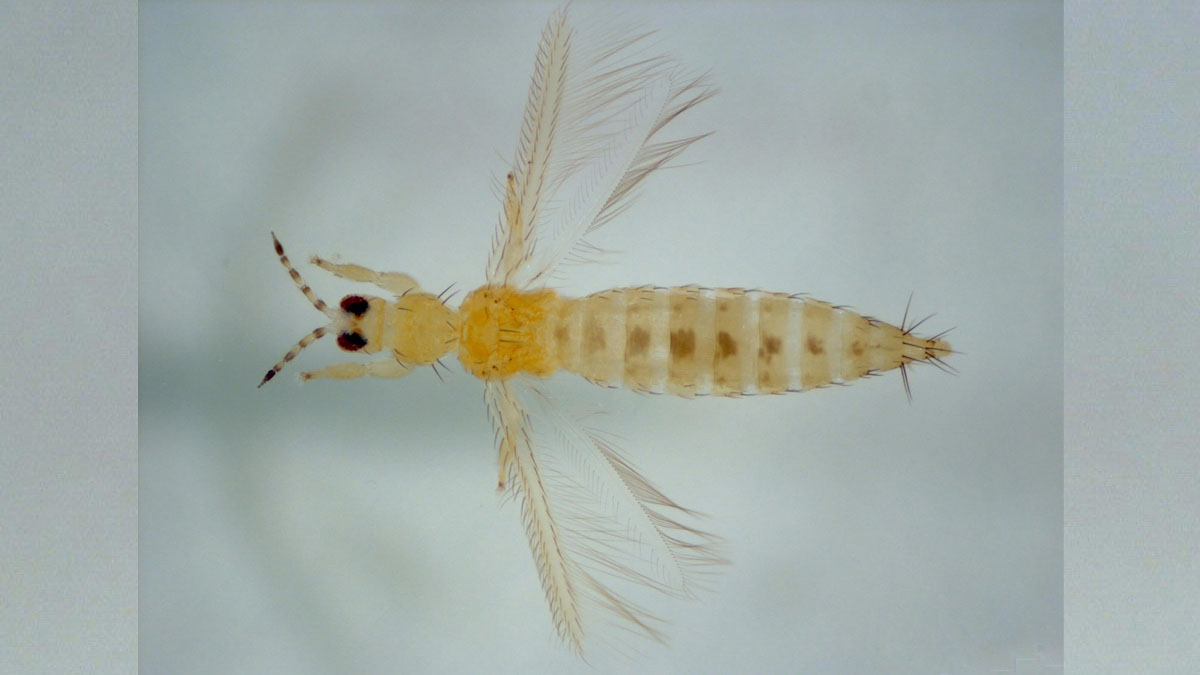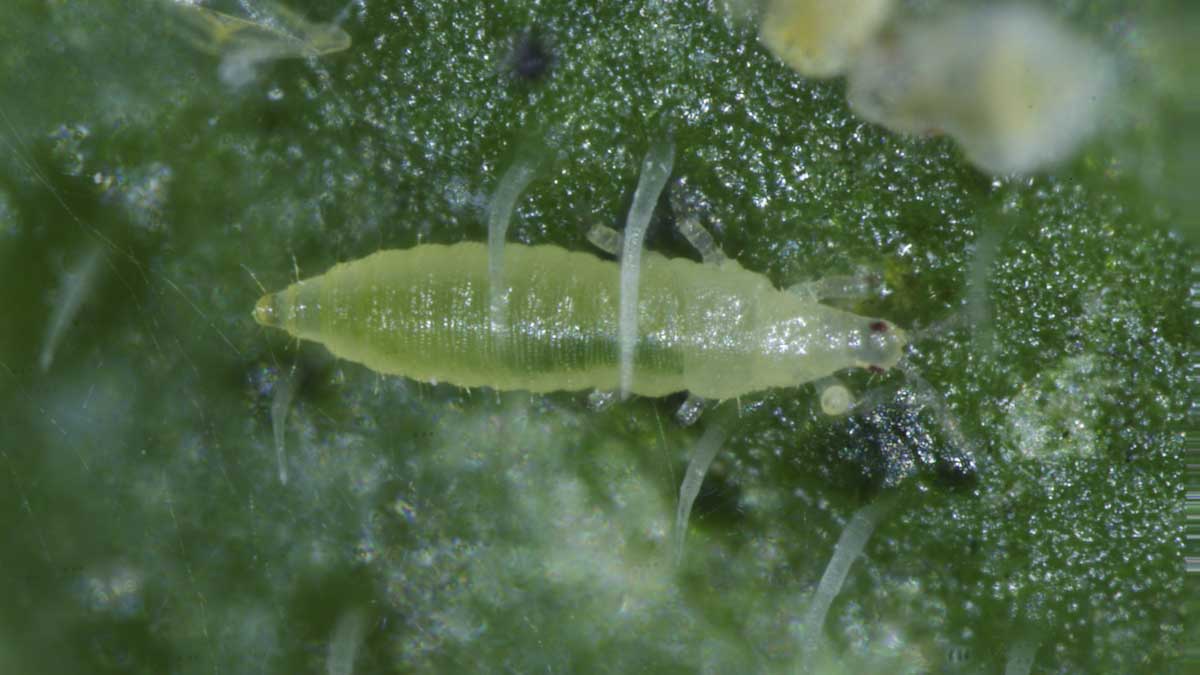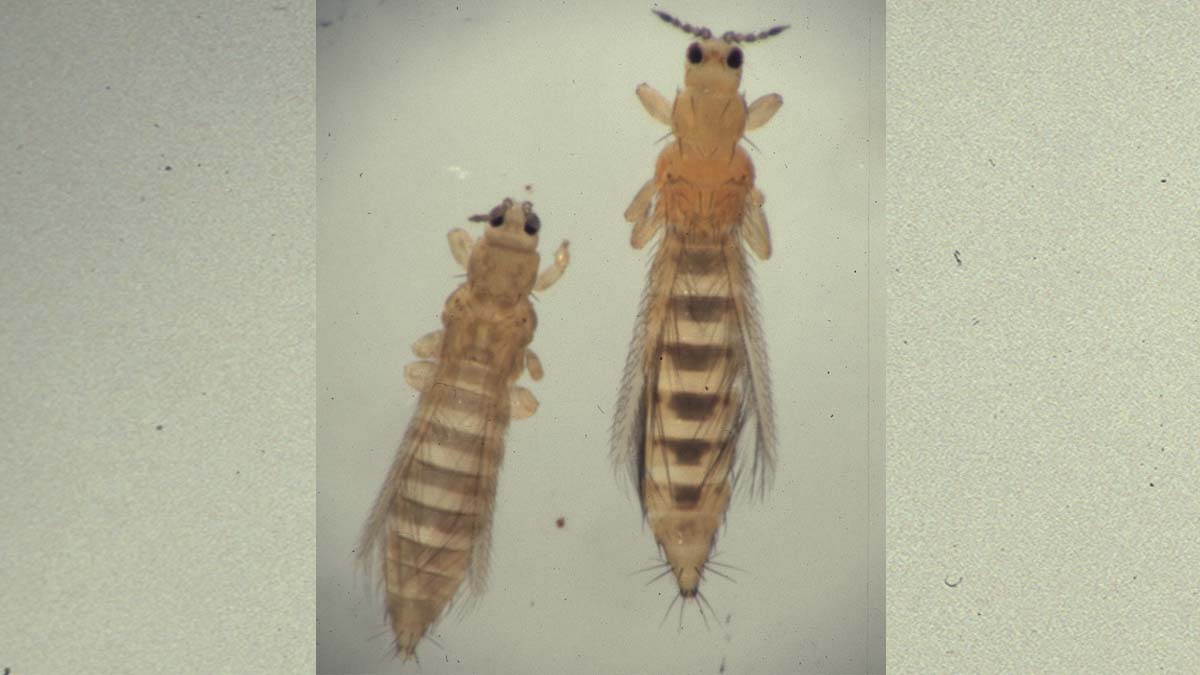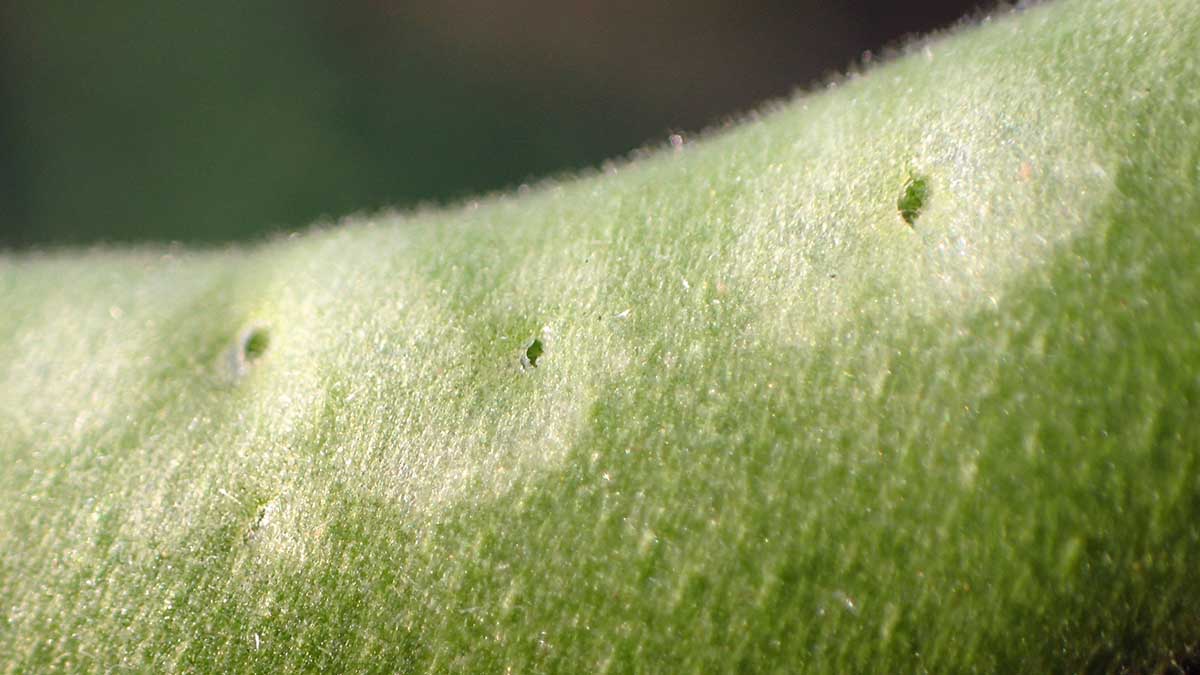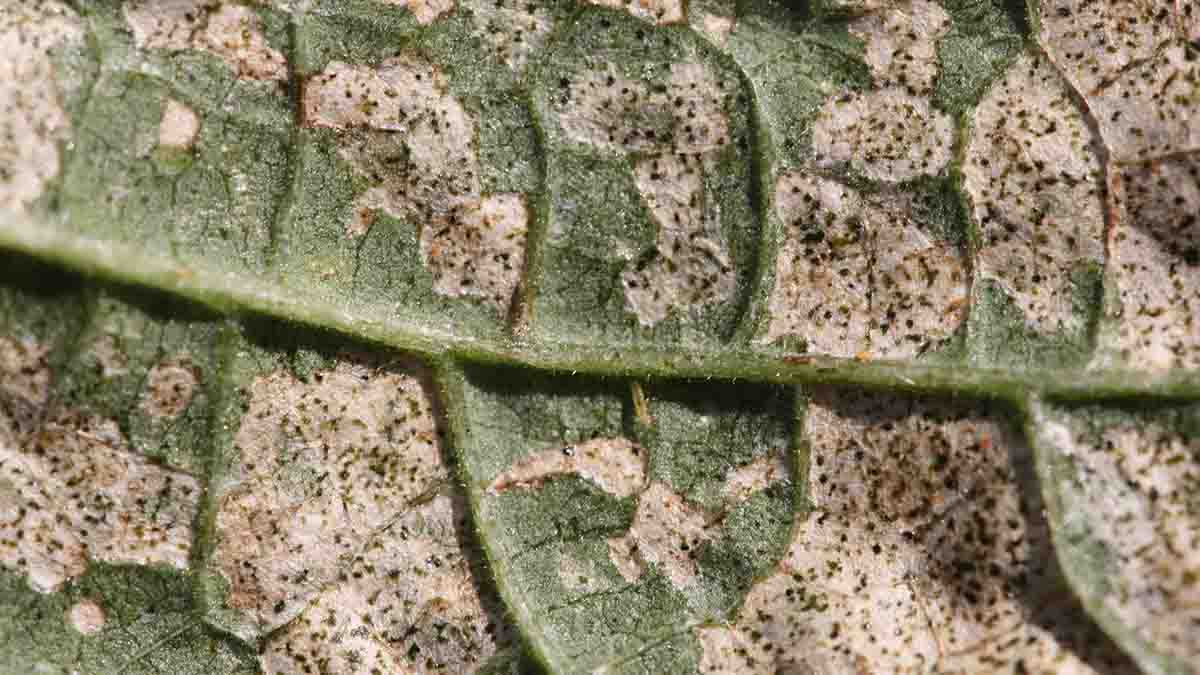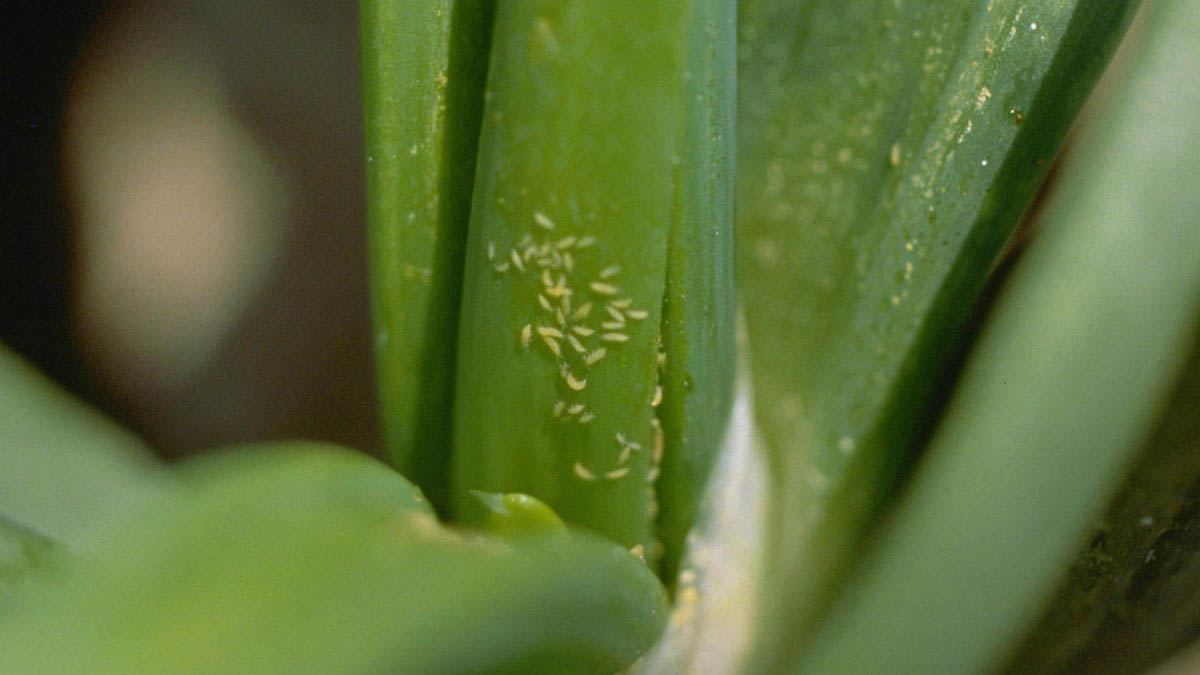Thrips
Pest Common Name
- Western Flower Thrips (Frankliniella occidentalis)
- Onion Thrips (Thrips tabaci)
- Crops: alfalfa, barley, clover, corn, onions, potato, wheat and others
- Vegetables: beans, brassicas, corn, cucurbits, garlic, leafy greens, onions, peas, peppers, tomatoes and others
- Fruits: apple, nectarine, peach, grapes, others
- Many ornamentals, grasses and weeds
- Greenhouse-grown plants
Western flower thrips and onion thrips are the primary damaging thrips species in Idaho. Adult thrips have thin, elongated bodies, feather-like wings and small, dark eyes (Figure 1). Thrips range in color from brown to yellow to cream, depending on the species, sex and life stage. Immature thrips (larvae) are also elongated, and mostly resemble adults though smaller and often more translucent (Figure 2). Thrips eggs are only visible with a microscope but scarring on some plant tissues, particularly young fruitlets, may be visible with the naked eye.
Differentiating between species of thrips can be key in diagnosing problems and managing infestations. In general, adult western flower thrips are generally around 1/32-1/16 inch (0.8-1.5 mm) in length, while onion thrips are slightly smaller (Figure 3). Western flower thrips have more hair on the front of their thorax than onion thrips, a chevron pattern on their abdominal segments where onion thrips have straight bands, and their antennae are segmented into eight segments as opposed to the onion thrips 7 (Figure 3). Keep in mind that differentiation between these thrips species often requires a microscope or consulting an entomologist or extension agent.



Biology
Western flower thrips and onion thrips both lay their eggs within plant tissues. Larvae hatch from eggs four to 15 days after eggs are laid and feed on plant tissues for two to three weeks before dropping into the soil to pupate. Adults can remain active, feeding and mating, for about a month. A single female can produce up to 200 eggs in her lifetime. Adults and larvae appear to prefer to feed on pollen, and so can often be found within blossoms. Thrips are poor fliers, but in windy conditions they can disperse great distances.
Damage
Thrips can damage plants in multiple ways. First, oviposition (egg laying) within plant tissues can leave scarring. This can be particularly problematic in fruits such as apples and nectarine, and some vegetables such as bean and pea pods (Figure 4).
The feeding of thrips can leave brown or silvery scarring and stippling on shoots, stems and leaves, and can also damage flowers. Feeding of thrips usually only causes cosmetic damage, though heavier infestations can cause leaf curling, stunted growth and death of the plant. Furthermore, hot and dry conditions can favor outbreaks of thrips while plants are already stressed, leading to more severe damage.
Lastly, thrips act as a carrier and transmitter of important plant viruses, which can spread through plant populations and cause much more severe damage and widespread plant death. Western flower thrips and onion thrips vector some key viruses such as tomato spotted wilt virus, tomato chlorotic spot virus and iris yellow spot virus. The symptoms of each virus vary between plant species and under different environmental conditions, so consult a specialist for their identification.
Monitoring
Adult thrips become active in the spring and are most easily monitored for using sticky traps, visual scouting, or by looking for characteristic oviposition (Figure 4) or feeding damage (silver or bleached surface scarring, dark fecal spots (Figure 5). Often it is best to focus visual scouting efforts on plant blooms. Monitoring thrips is difficult because of their size. Thrips are best identified under a loupe or low powered microscope or taken to your local Extension educator.
Monitoring practices and economic thresholds differ between crops.
In vegetable crops — To monitor thrips, shake leaves over a white paper and look for thrips to fall off onto the paper. Also look at the bases of leaves and new growth where thrips sometimes congregate (Figure 5). Though no formal economic threshold exists for most vegetable crops, if more than 30 thrips are observed per leaf and damage is being seen on the plants, control may be merited in high value crops. If thrips infestations are severe when plants are not fully established (until three to four weeks after planting) treatment may be warranted.


In onions — Monitor for thrips in onions by looking for the characteristic sliver damage they cause, and by scouting for congregations of thrips within the necks of plants (Figure 6). Scout for thrips in multiple, random places around the field. Keep in mind that young plants, and plants in the early bulbing stage, are most likely to suffer economic damage from thrips, so scouting should be more frequent leading up to and through this stage. There is no formal economic threshold for thrips in onions in Idaho, but there are some general thresholds that have helped guide economic management in Idaho and neighboring states.
- For young plants in the early season, consider treatment when an average of two or more thrips are found per plant
- For plants in the mid- season, consider treatment when an average of 20 or more thrips are found per plant
- More mature plants, in the late season, can tolerate larger numbers of thrips without suffering economic damage
- Onions to be sold in the fresh market with leaves attached suffer severely reduced marketability when thrips scarring is present, so consider treatment as soon as thrips feeding damage is detected

In fruit trees — Monitor blossoms for thrips by shaking them vigorously over a white cup or piece of paper, and count only the large, adult female thrips that fall out. This can be done without removing blossoms from the tree. Sample four blossom clusters per tree and at least four trees per block and cultivar.
In hay crops such as alfalfa — Monitor thrips by inserting leaves from multiple stems into a jar with rubbing alcohol and let sit for several hours. Strain the alcohol through a coffee filter and count the number of thrips captured. Control is merited when more than 50 thrips are present for every six stems.
Management
Primary Management Tactics
Sanitation is a key practice in the management of thrips and the viruses they vector. Remove all unneeded plant material promptly after harvest or at the end of the season and manage weeds that can serve as reservoirs both for thrips and viruses. Thrips damage rarely reaches economic levels, so take note of economic thresholds when considering treatment options.
Physical
- Prune infected leaves and stems to reduce population sizes
- In greenhouse settings, use a thrips screen to cover all openings to avoid colonization
- In greenhouses and gardens, younger herbaceous plants can be protected by a thrips screen row cover similar to a low tunnel, which can then be removed when the plant is more mature and can handle more thrips damage
Cultural
- Plant thrips resistant cultivars
- Avoid planting susceptible plants near weedy areas or next to fields or grasslands
- Control weeds close to susceptible plants
- Consider the use of reflective mulches which interfere with thrips ability to locate host plants
Biological
- Avoid the use of broad-spectrum insecticides where possible to conserve resident predators of thrips such as lacewings, minute pirate bugs, ladybugs and predatory thrips
Chemical
- There is a wide variety of insecticides labeled for thrips, though they have rapidly developed tolerance to many. To reduce the risk of tolerance, alternate insecticides from different groups if multiple applications are necessary.
- Applications should be made only when abundance or damage reaches economic levels, as many insecticides that are labeled for thrips are also toxic to beneficial insects
- Thrips are present throughout the year and become active in the spring. Applications in the spring may help keep populations from increasing.
- Insecticidal soaps and neem oil may be effective at controlling thrips, while reducing risk to beneficials and the environment compared to many synthetic insecticides
- Recommendations for pesticides to use in the management of thrips in various crops and landscape plants can be found on the PNW Pest Management Handbooks website
Pesticide Warning
Always read and follow the instructions printed on the pesticide label. The pesticide recommendations in this University of Idaho webpage do not substitute for instructions on the label. Pesticide laws and labels change frequently and may have changed since this publication was written. Some pesticides may have been withdrawn or had certain uses prohibited. Use pesticides with care. Do not use a pesticide unless the specific plant, animal or other application site is specifically listed on the label. Store pesticides in their original containers and keep them out of the reach of children, pets and livestock.
Trade Names — To simplify information, trade names have been used. No endorsement of named products is intended nor is criticism implied of similar products not mentioned.
Groundwater — To protect groundwater, when there is a choice of pesticides, the applicator should use the product least likely to leach.
- Figure 1. Jack T. Reed, Mississippi State University, Bugwood.org
- Figure 2. Erik J. Wenninger, University of Idaho
- Figure 3. Alton N. Sparks, Jr., University of Georgia, Bugwood.org
- Figures 4-6. Whitney Cranshaw, Colorado State University, Bugwood.org
Joseph Sagers, Extension Educator
Desiree Wickwar, Entomologist, IPM Project Manager
2023







